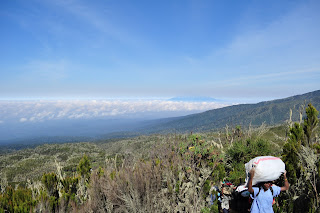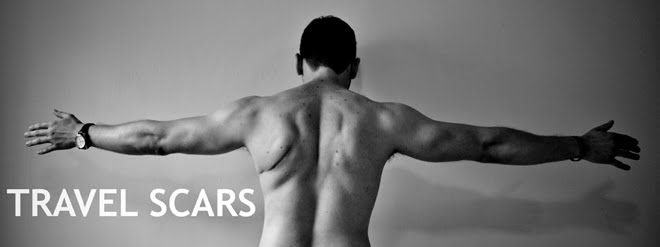After spending the night in the VIP section (i.e. tickets they sell to all the white people) in the ridiculously slow ferry from Stone Town to Dar es Salaam, we were back in mainland Tanzania.
We had found out the bus company we planned on taking literally had no mechanically functioning buses so we had to find another company which could complete the journey. We eventually did and the bus ride from Dar to Moshi was actually quite enjoyable: the roads were smooth and well maintained and they played several unintentionally-hilarious, Nigerian-inspired Tanzanian films.
We arrived in Moshi in the late afternoon and we were immediately greeted by someone intent on selling us a trek up Kilimanjaro. Before our trip, Chris and I had decided that since we traveled all this way to get here, we actually wanted to enjoy our hike up Kili and we therefore opted for the 6-night, 7-day trek rather than the usual 5-night, 6-day itinerary that most people follow.
The first company we were escorted to was Bryson Adventures and it turned out to be the best deal and fitted all of our requirements. We would be joining a group of 6 Americans who had been organizing this trek for quite some time and because of our late arrival, Bryson decided to keep Chris and I segregated from the gung ho group of mountain-climbing enthusiasts.
We soon found a hotel for a reasonable price, but no price would be too great for the heavenly views we were given of Kili. The setting-sun painted the snow-capped peak with a pink hue that even the most skilled painter would have difficulty reproducing. We sat on the hotel terrace and gazed at Africa's tallest peak, unsure of the daunting task which lay before us. Obviously my 2-and-a-half hours of training before leaving Montreal and our excessive preparatory drinking in Zanzibar would pay off in spades.

We gave ourselves 3 days of lethargy, inactivity and sobriety in order to rest our bodies and minds before commencing our ascent. While enjoying one of our days of sloth, we met a bearded, safari-gear wearing New Yorker named Erik ("with a k" as he would always be sure to point out). We compared our trekking company offers and assured each other that we had received a good deal.
Chris and I would be picked up at 8:15 am by Bryson himself and would be driven to the gate of Kilimanjaro National Park in order to embark on our potentially life-changing voyage. That night I was overwrought with anxiety and slept very little. I was doubting my physiological ability to make the summit and worried about the effects of altitude on my left lung and thorax following the major surgery I underwent less than a year before.
A person's response to altitude can only be assessed once exposed to it: no amount of physical training or mental preparation can prevent or reverse altitude sickness if one is predisposed to get it. My fate and success was therefore out of my hands. The only task for my idle hands to perform was to clasp in prayer and hope that my efforts and money will not be spent in vain.
The following day we were picked up by Bryson at 8:15 am Africa time (i.e. 9:00 am) and were taken to the gate of the national park. We introduced ourselves to the American group we would be joining and were slightly intimidated by their prior accomplishments: several of them had climbed higher mountains than Kili and one woman in their group had done an Ironman triathlon and had qualified for the Boston Marathon. It looked like we would have our work cut out for us.

Our guide's name was Robert and his success was our success. At least that's what he told us.

We started at an altitude of 1800m (5,906ft) and by the end of day one, we were slated to camp at 3000m (10,000 ft), already obliterating the previous highest altitude I've reached at the summit of Mount Washington in New Hampshire. It is also mind blowing to imagine 10,000 feet is the height at which we jumped out of a plane when we went skydiving in Namibia!

Robert explained the two fundamental principles of climbing Kilimanjaro:
1- Pole Pole or slowly slowly in Swahili: the turtle-like pace you hike in order to preserve your strength, prevent fatigue and to facilitate acclimatization. One foot rarely completely passes the other when taking a step. It is actually quite amazing how you don't tire yourself out and that you actually still cover considerable distance despite the slow pace of the ascent.
2- SWAT: When asked what it stands for, we responded Special Weapons Artillery Tactics. We were a bit off. For Robert it stands for
Sugar: for energy
Water
Always clean: your hands and face at least
Temperature: you need to stay warm
These two principles should be all you need to conquer Kili. I'll believe it when I see it!

I was wearing my top-of-the-line hiking gear: torn camouflage shorts, purple H&M v-neck T-shirt, Nike ankle socks and rental boots I got from Bryson. Needless to say I got blisters on both heels after a mere 2-and-a-half hours. Perfect!

Our first day's hike was great: nice pace, beautiful rain-forest scenery and ample breaks to allow us to stay hydrated and to prevent fatigue. Unfortunately, my night was still restless and I regrettably had J-Lo's "My love don't cost a thing" stuck in my head for the whole night.


The following day I taped up my feet and doffed my rental boots for some more appropriate footwear: my grip-less Adidas street shoes. We left Machame camp at 8:45 am and pretty much continued to climb vertically for the entirety of the day. Very pole pole mind you, so it wasn't that bad.
What I neglected to mention earlier is that in addition to a guide, we were also accompanied by several porters. Each porter follows the same route that we do. The same narrow trails, loose rocks and steady inclines; but rather than a 10-15 pound day-pack on their backs, they carry 40-50lbs of gear (our tents, equipment, etc) on either their heads or behind their necks! It does not look enjoyable in the slightest.


On this day's hike, the vegetation shifted from rain-forest to moorland: almost desert-like vegetation with small shrubs and few animals. Our final altitude for day 2 was 3840m (12,600ft).
That night I was no longer haunted by the sultry voice of J-Lo and I actually managed to have a good night's sleep.
Our third day was our first acclimatization hike where you utilize "climb high, sleep low", allowing your body to get accustomed to a decreased oxygen concentration while you sleep. Our highest point was 4600m (15,090ft) and we slept at an elevation of only 3950m (12,960ft) to allow for acclimatization.
Minor headaches from previous days aside, after this hike I had a pretty substantial headache, but luckily no nausea or other problematic symptoms related to altitude sickness.
It looks like I may be able to do this after all!



No comments:
Post a Comment